I am only going to post images where I have translated the menus, so that you can see what is what. When you play the game you will be able to compare it to my graphics to navigate. If you would like me to upload some raw, Japanese graphics of the game, send me a message on Twitter or IM me at T3h HT (AIM) or edelas2@gmail.com (MSN). I do not often check my email.
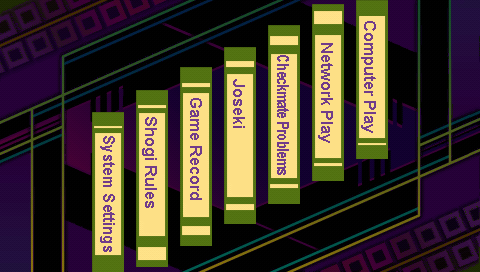 The first thing you will need to note is that with this game, as well as most (if not all?) Japanese PSP games, O is the accept button and X is the cancel button. Anyway, this is the main menu that you will see after beginning a new game. The options go from right to left in Japanese vertical style. The options are Computer Play, Network Play, Checkmate Problems (Tsume Shogi), Joseki, Game Record, Shogi Rules, and System Settings. Game Record will let you see how many times you've won or lost against the computer and how many moves you made each game. I haven't been able to tell if you're able to check the notation of past games. I'm not sure of Network Play means over the internet or over a local network. I can't connect to anything so I don't know what to do with that.
The first thing you will need to note is that with this game, as well as most (if not all?) Japanese PSP games, O is the accept button and X is the cancel button. Anyway, this is the main menu that you will see after beginning a new game. The options go from right to left in Japanese vertical style. The options are Computer Play, Network Play, Checkmate Problems (Tsume Shogi), Joseki, Game Record, Shogi Rules, and System Settings. Game Record will let you see how many times you've won or lost against the computer and how many moves you made each game. I haven't been able to tell if you're able to check the notation of past games. I'm not sure of Network Play means over the internet or over a local network. I can't connect to anything so I don't know what to do with that.
If you want to use one-character pieces, go to System Settings and go down to this option, and choose the second setting. I don't feel like this menu is important to translate; if you want to mess around with the settings they're not that difficult to figure out.

This is the screen you will see when you choose Computer Play. I'm sorry I forgot to translate the Thinking Time, it should be 1 minute and 5 occurences. I'm not sure what that means, sorry. ^^; The handicap options are No Handicap, Lance Handicap, Bishop Handicap, Rook Handicap, Rook+Lance Handicap, Two Piece Handicap, Four Piece Handicap, and Six Piece Handicap. The options for Black Player are Pawn Toss, Player, and Computer. Byoyomi is the amount of time you can use per move after you've run out of time, and it refreshes back to its original number after every move. For example, in a 30 minute game, after you've used your 30 minutes of time, each move you make must be 30 seconds if you are playing with a 30 second byoyomi.
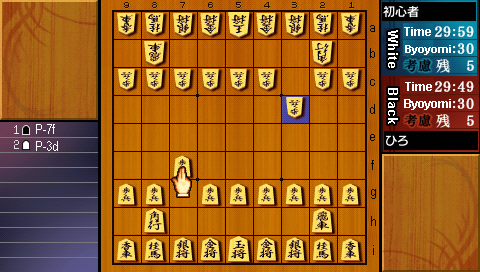
This is the game menu. Even though I translated the notation, it will show up in Japanese style (for example, those moves are listed as 1.七六歩 2.三四歩 in the game). I forgot to translate the menus under Byoyomi, but it's "Thoughts Remaining" or something to that effect. Once again I don't know what that means, sorry. The ranks are also listed in kanji rather than letters like this (一 through 九). The words in the black bars are the names of the players.
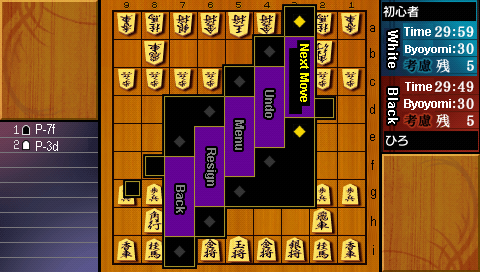 These are the menus in the game mode. "Next Move" will suggest what your next move should be.
These are the menus in the game mode. "Next Move" will suggest what your next move should be.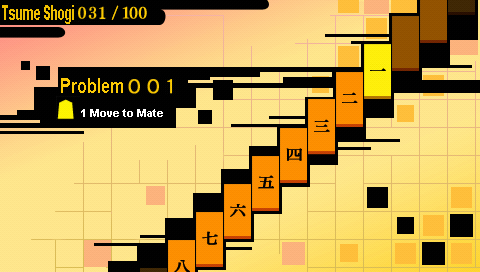 This is the Checkmate Problems menu. It's very self explanatory. The kanji in the boxes is the number of the problem, which appears in the black box on the left. The Japanese below the problem number just tells you how many moves to checkmate it is.
This is the Checkmate Problems menu. It's very self explanatory. The kanji in the boxes is the number of the problem, which appears in the black box on the left. The Japanese below the problem number just tells you how many moves to checkmate it is.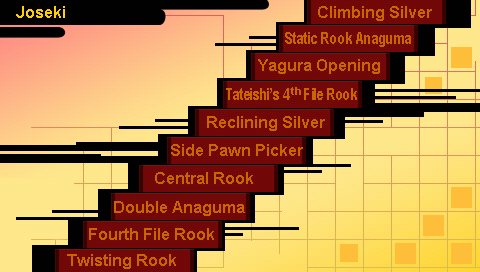 This is the joseki menu. As you can see they have a good variety of opening josekis, so be sure to check them out and pick a favorite.
This is the joseki menu. As you can see they have a good variety of opening josekis, so be sure to check them out and pick a favorite.And that's it for this English-speaker's guide to Saikyou Shogi Bonanza. With this information, you will be able to enjoy this game to a good extent. If you buy it and use this guide to play it, please be sure to comment on this blog or message me to let me know, I'll really appreciate it.
A huge thanks to Hans Geuns' Basic Shogi Vocabulary for translations of most of the openings and to my friends Trent, Hawkeye, and crazysjd89 for various small translations within the menus.

No comments:
Post a Comment